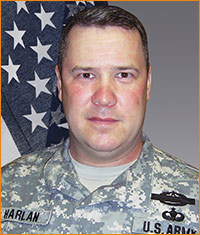2008 Soldier of the Year
winner

First Sgt William Harlan
Grew up in Walnut Creek, Calif., and enlisted in the Army at 20. Served tours in Iraq in 2005-06 and 1990-91, and in Afghanistan in 2002-03. Harlan has a daughter, Katy, 13, and a son, Andrew, 11.
FORT LEWIS, Washington - First Sgt. William C. Harlan remembers seeing the pothole. He could not see the bomb hidden inside.
Harlan was standing in the squad leader hatch of a Stryker armored vehicle, leading a patrol in Mosul, Iraq. The Stryker passed directly over the pothole and the bomb erupted with massive force, catapulting the 20-ton vehicle several feet into the air.
Harlan was immediately ejected, blasted some 30 feet away.
"A staff sergeant, two vehicles back, he saw me fly out," Harlan recalled of the March 2006 incident. "I looked like a rag doll. He was convinced I was already dead."
The platoon medic, accompanied by soldiers, rushed over to administer first aid. Harlan, though critically injured, remained calm and directed the security and evacuation plan before being taken to a field hospital.
He earned a Purple Heart for his service that day in Iraq. But for leadership demonstrated last year in helping other wounded troops cope with suffering and rehabilitation, Harlan is the 2008 Army Times Soldier of the Year.
"He could have easily taken a medical discharge, which he could have done with honor. But he chose to stay and chose to serve," Col. John G. Norris said in an interview. Norris was one of several soldiers who nominated Harlan for the honor.
News of the bombing frightened Harlan's family, especially his children, Katy, 13, and Andrew, 11. Harlan had returned safely from previous tours in Afghanistan in 2002-03 and Iraq in 1990-91.
"We were all scared because none of us knew what was going to happen," Katy said as tears welled in her eyes. "Our mom told us our dad was hurt really bad, he was blown up, and that he might not pull through."
Harlan was hospitalized stateside for three months. He underwent 16 major surgeries to repair dozens of broken bones in his legs, and torn ligaments in his right knee. He recovered and walks again, and despite lingering physical and mental pain from the injury, elected to continue serving on active duty.
Indeed, even before he was medically cleared for duty, Harlan volunteered to help establish the Warrior Transition Battalion at Fort Lewis, Wash., a unit designed to help rehabilitate injured combat soldiers.
Harlan also volunteered to spend time with the children of fallen soldiers as part of the post's Tragedy Assistance Program for Survivors (TAPS).
"I needed to give something back to those who had helped me recover," he said.
Harlan, 39, grew up in Walnut Creek, Calif. He enlisted in the Army at age 20 in part because he wanted to serve his country. He opted against becoming an officer.
"I really decided I had more to offer the Army as an NCO than an officer," he said. "It's a personality thing. You have much more direct influence on young soldiers' lives as an NCO than you do as an officer."
His enthusiasm for the job hasn't been lost on his colleagues. "Leadership from the front, always," Capt. Matthew T. Kirby wrote of Harlan. "Once in a career, you get the opportunity to serve with someone of his caliber."
Harlan has received numerous awards during his military career, which he began as a mortarman with the 82nd Airborne Division. His Purple Heart and a pair of Bronze Stars adorn the walls of his apartment near Fort Lewis.
Harlan said an investigation into the Stryker bombing indicated the improvised explosive device was likely pressure-triggered and placed there by Sunni insurgents. Still, he said, he would return to Iraq without hesitation.
Above all, Harlan said, he hopes his story inspires others. "I look at this as a great thing for all wounded soldiers who have struggled to come back," he said.
